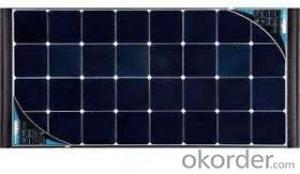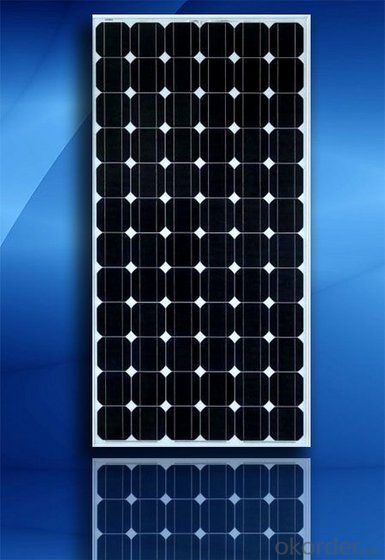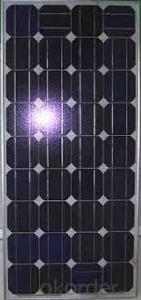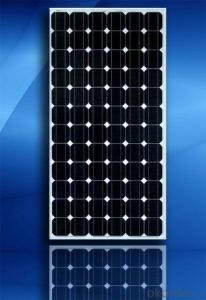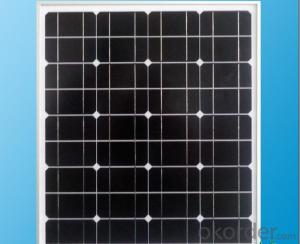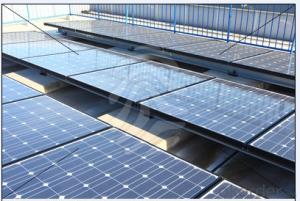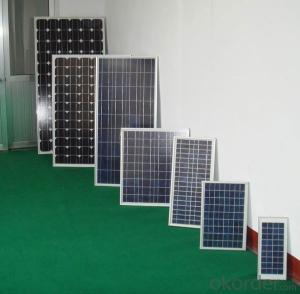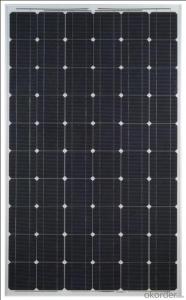PVA Solar Panels - Hot Sale 185W Monocrystalline Solar Panel with 25 Years Warranty CNBM
- Loading Port:
- Qingdao
- Payment Terms:
- TT OR LC
- Min Order Qty:
- 10 set
- Supply Capability:
- 300000 set/month
OKorder Service Pledge
OKorder Financial Service
You Might Also Like
Monocrystalline Solar Panel with 185W
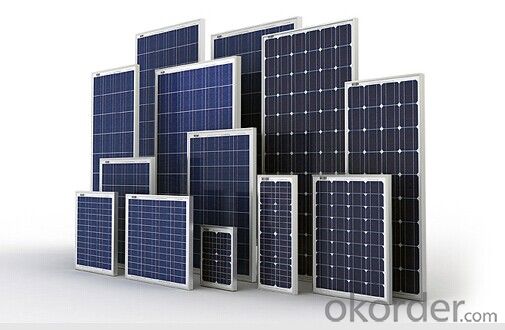
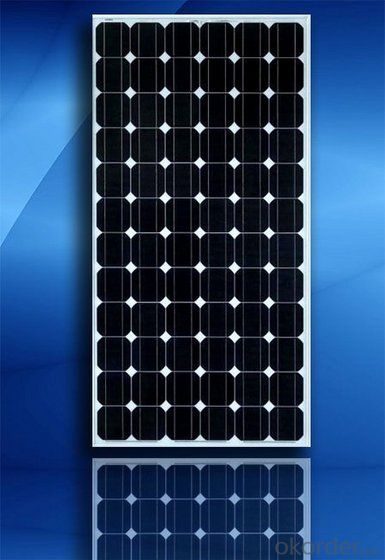
Monocrystalline Solar Modules
We offers a range of small, medium and large monocrystalline solar modules, designed for a range of requirements.
Specifications:
Tolerance | +/- 3% |
Cell | Monocrystalline silicon solar cells |
N0. of Cells | 72 (12 x 6) |
Dimension of Modules (mm) | 1581 x 809 x 40 |
Weight (kg) | 15.5 |
Limits:
Operating Temperature | -40~+85? |
Storage Temperature | -40~+85? |
Maximum System Voltage | 1000 VDC max. |
Hail Impact | Diameter of 28mm with impact speed of 86km/h |
Temperature and Coefficients:
NOCT | 48C+/-2? |
Voltage temperature coefficient (%/K) | -0.34 |
Current temperature coefficient (%/K) | 0.09 |
Power temperature coefficient (%/K) | -0.37 |
Characteristics:
Model: | SGM-160D | SGM-165D | SGM-170D |
Max-power voltage Vmp (V) | 34.5 | 35.4 | 35.8 |
Max-power current Imp (A) | 4.64 | 4.66 | 4.75 |
Open-circuit voltage Voc (V) | 41.75 | 43.6 | 43.32 |
Short-Circuit Current Isc (A) | 5.32 | 5.08 | 5.38 |
Max-power Pm(W) | 160 | 165 | 170 |
Model: | SGM-175D | SGM-180D | SGM-185D |
Max-power voltage Vmp (V) | 36.1 | 36.2 | 36.2 |
Max-power current Imp (A) | 4.85 | 4.97 | 5.11 |
Open-circuit voltage Voc (V) | 43.68 | 43.8 | 44.8 |
Short-Circuit Current Isc (A) | 5.49 | 5.48 | 5.51 |
Max-power Pm(W) | 175 | 180 | 185 |
STC: Irradiance 1000W/m2, Module temperature 25?, AM=1.5
Monocrystalline Solar Panels Specifications Range
Maximum Power (Pm) | Dimension | Weight | Operating Voltage (Vmp) | Operating Current (Imp) | Open Circuit Voltage (Voc) | Short Circuit Current (Isc) |
3W | 158x241x25mm | 0.5kg | 8.5V | 0.36A | 10.5V | 0.4A |
4W | 308x166x25mm | 0.77kg | 8.5V | 0.47A | 10.5V | 0.54A |
4W | 308.x166x25mm | 0.77kg | 16.8V | 0.24A | 21V | 0.27A |
5W | 296x215x25mm | 0.3kg | 16.8V | 0.48a | 21V | 0.54A |
10W | 286x406x25mm | 1.5kg | 16.8V | 0.59A | 21V | 0.66A |
12W | 286x406x25mm | 1.5kg | 16.8V | 0.71A | 21V | 0.8A |
14W | 286x541x25mm | 2kg | 16.8V | 0.83A | 21V | 0.96A |
16W | 286x541x25mm | 2kg | 17.2V | 0.93A | 21.5V | 0.99A |
18W | 296x541x25mm | 2.4kg | 18.8V | 1.07A | 21V | 1.2A |
20W | 296x641x25mm | 2.4kg | 17.2V | 1.15A | 21.5V | 1.24A |
24W | 541x451x25mm | 3.15kg | 16.8V | 1.14A | 21V | 1.56A |
26W | 541x451x25mm | 3.15kg | 17.2V | 1.51A | 21.5V | 1.63A |
30W | 296x966x25mm | 3.85kg | 16.8V | 1.78A | 21V | 2.03A |
36W | 541x641x35mm | 4.7kg | 16.8V | 2.14a | 21V | 2.4A |
40W | 541x641x35mm | 4.7kg | 17.2V | 2.33A | 21.5V | 2.5A |
55W | 1057x457x35mm | 6.6kg | 17.6V | 3.12A | 21.6V | 3.3A |
70W | 546x1196x35mm | 8.5kg | 16.8V | 4.15A | 21V | 4.7A |
75W | 546x1196x35mm | 8.5kg | 17.2V | 4.36A | 21.5V | 4.8A |
80W | 546x1196x35mm | 8.5kg | 17.6V | 4.55A | 21.6V | 4.9A |
110W | 1066x811x40mm | 11.8kg | 17.6V | 6.25A | 21.6V | 6.6A |
150W | 1066x811x40mm | 14kg | 34.4V | 4.36A | 43.2V | 4.7A |
- Q: i have to do a science fair project and thought it would be cool to make a solar powered vw bus. i have 2 6volt solar panels to power a dc motor that works off of 9v 2v or 8v. i also bought a 2nd motor because the first wasnt workin for us. this one is a 3v motor. ive had them in the sun but they wont work. please help, thanks
- You didn't say how much power your panels can produce, or how much power (current x volts) the motors require. The panels must meet or exceed what the motor requires. You might need to get a very small motor and a little gearbox out of some other motorized toy, or at least a small pinion gear for the motor and a larger ring gear that can be attached to an axle (similar to how RC cars accomplish their drive train). A worm gear drive set might be even better if the motor / solar panel combination isn't very powerful - it'll go slowly, but some movement is better than no movement. If you put the panels in series, a 2 V motor should be the best match (again, only if its power requirements are small enough). If you want to try running the 3 volt motor off the panels, you might try paralleling them (make sure you get the polarity right or they'll try to kill each other) - you'll still be mis-matched, but if the motor requires less power than the 9/2/8 volt motor(s), it might work. If you have or can acquire a multi-meter, you'll be able to measure the voltages and currents and that will not only help you see what's going on, but adding some details might help others help you get this working.
- Q: How does the snow cover get removed from the panels?
- Just okorder /... As an aside the efficiency of the panels will also be maintained if the panels are cleaned of dust and debris. The maintenance of removing snow and dust is one argument for having the panels on a rack on the ground. Solar Thermal panels are intended to capture the sun's heat. Two types that make hot water are flat panels and vacuum tube collectors. The vacuum tube collectors work better in colder and cloudy areas but their efficiency prevents heat loss that might melt snow. Most of a light snow will fall between them but you are back to maintenance with a heavier snow. Flat panels are less efficient and will melt a light snow off of the panels for a heavier snow you will need the roof rake. The last type of solar panel are solar air panels. These are most often mounted on the side of a house rather than the roof as they are intended to provide hot air to the living spaces. They are essentially like little greenhouses. Unless the snow is building up against the side of the house these should be free from a snow problem.
- Q: Can solar panels be installed on factories or industrial buildings?
- Yes, solar panels can definitely be installed on factories or industrial buildings. In fact, these large structures often have expansive rooftops that can accommodate a considerable number of solar panels. Installing solar panels on factories or industrial buildings not only helps reduce their reliance on traditional energy sources, but also provides an opportunity for these establishments to generate their own sustainable and clean electricity.
- Q: Can solar panels be damaged by birds or rodents?
- Yes, solar panels can be damaged by birds or rodents. Birds may build nests underneath the panels or perch on them, causing potential damage to the wiring or scratching the surface. Rodents like squirrels or rats can chew on the wires, leading to electrical issues. Therefore, it is important to take preventive measures such as installing bird deterrents or protective barriers to minimize the risks posed by these animals.
- Q: Can solar panels be used in conjunction with a backup generator?
- Yes, solar panels can be used in conjunction with a backup generator. This setup is known as a hybrid system. During periods of sunlight, solar panels generate electricity and can power a home or facility. Any excess energy can be stored in batteries or fed back into the grid. When sunlight is insufficient, a backup generator can automatically kick in to provide electricity, ensuring a continuous power supply.
- Q: Can solar panels be used for powering a concert venue or entertainment center?
- Yes, solar panels can certainly be used to power a concert venue or entertainment center. By harnessing the energy of the sun and converting it into electricity, solar panels can provide a sustainable and renewable source of power to meet the energy demands of such large venues. With advancements in solar technology and the ability to store excess energy, solar panels can effectively contribute to reducing carbon emissions and promoting a greener environment for entertainment spaces.
- Q: Can solar panels be used to power streetlights or outdoor lighting?
- Yes, solar panels can be used to power streetlights or outdoor lighting. Solar panels convert sunlight into electricity, which can be stored in batteries and used to power streetlights or outdoor lighting fixtures during nighttime. This helps to reduce reliance on traditional grid-based electricity and promotes more sustainable and environmentally friendly lighting solutions.
- Q: Can solar panels be used for powering a wastewater treatment plant?
- Yes, solar panels can be used to power a wastewater treatment plant. Solar energy can be harnessed and converted into electricity, making it a sustainable and environmentally friendly option for powering such facilities. The generated electricity can be utilized to operate various equipment and processes involved in wastewater treatment, reducing dependency on traditional power sources and minimizing the carbon footprint of the plant.
- Q: Could you have a solar panel in space that would transmit electricity remotely? Maybe have some kind of receiving antenna to pick up the energy? Perhaps there could be a string of them orbiting the Earth?Why wouldn't that work?
- Amazing how antique technology is so easily forgotten. Nikola Tesla first introduced the idea of wireless energy transmission in 89 and proved it by 899 in Colorado Springs, CO. He proved the Earth itself was a conductor of electricity. He also successfully conducted long-distance wireless energy transmission and reception. He wrote about the ability to wirelessly send electricity from a few central sources using longitudinal waves and magnetic flux all around the globe to be received at any point therefore electricity could be accepted by all uniformly. Although the means by which to do it was extremely far fetched, his theories are solid.
- Q: okay so my teacher is trying to install a solar panel but we have a problem we don't know where to ground it because it will be a movil house. guys do you have any ideas?
- Typically you mount it with the frame as a ground and you ground the frame with a wire or cable tied into the ground when the mobile home is parked.
Send your message to us
PVA Solar Panels - Hot Sale 185W Monocrystalline Solar Panel with 25 Years Warranty CNBM
- Loading Port:
- Qingdao
- Payment Terms:
- TT OR LC
- Min Order Qty:
- 10 set
- Supply Capability:
- 300000 set/month
OKorder Service Pledge
OKorder Financial Service
Similar products
Hot products
Hot Searches
